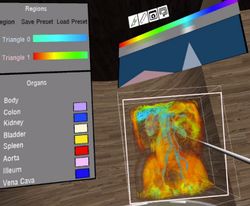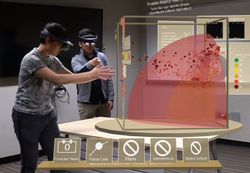Difference between revisions of "Projects"
From Immersive Visualization Lab Wiki
(→3D Medical Imaging Pilot (Larry Smarr, Jurgen Schulze, 2018-2021)) |
|||
| Line 1: | Line 1: | ||
| − | =<b> | + | =<b>Recent Projects</b>= |
| − | ===Immersive Visualization Center (Jurgen Schulze, | + | ===Immersive Visualization Center (Jurgen Schulze, 2020-2021)=== |
<table> | <table> | ||
<tr> | <tr> | ||
Revision as of 22:02, 9 September 2021
Recent Projects
Immersive Visualization Center (Jurgen Schulze, 2020-2021)
 |
Dr. Schulze founded the Immersive Visualization Center (IVC) to bring together immersive visualization researchers and students with researchers from research domains which have a need for immersive visualization using virtual reality or augmented reality technologies. The IVC is located at UCSD's Qualcomm Institute. |
3D Medical Imaging Pilot (Larry Smarr, Jurgen Schulze, 2018-2021)
 |
In this $1.7M collaborative grant with Dr. Smarr we have been working on developing software tools to support surgical planning, training and patient education for Crohn's disease. Publications:
Videos: |
XAI (Jurgen Schulze, 2017-2021)
| The effectiveness of AI systems is limited by the machine’s current inability to explain their decisions and actions to human users. The Department of Defense (DoD) is facing challenges that demand more intelligent, autonomous, and symbiotic systems. The Explainable AI (XAI) program aims to create a suite of machine learning techniques that produce more explainable models, while maintaining a high level of learning performance (prediction accuracy); and enable human users to understand, appropriately trust, and effectively manage the emerging generation of artificially intelligent partners. This project is a collaboration with the Stanford Research Institute (SRI) Princeton, NJ. Our responsibility is the development of the web interface, as well as in-person user studies, for which we recruited over 100 subjects so far. Publications:
|
DataCube (Jurgen Schulze, Wanze Xie, Nadir Weibel, 2018-2019)
 |
In this project for the Microsoft HoloLens we developed a Bodylogical-powered augmented reality tool for the Microsoft HoloLens to analyze the health of a population such as the employees of a corporation. Publications:
Videos: |
Catalyst (Tom Levy, Jurgen Schulze, 2017-2019)
 |
This collaborative grant with Prof. Levy is a UCOP funded $1.07M Catalyst project on cyber-archaeology, titled "3-D Digital Preservation of At-Risk Global Cultural Heritage". The goal was the development of software and hardware infrastructure to support the digital preservation and dissemination of 3D cyber-archaeology data, such as point clouds, panoramic images and 3D models. Publications:
|
CalVR (Andrew Prudhomme, Philip Weber, Giovanni Aguirre, Jurgen Schulze, since 2010)
 |
CalVR is our virtual reality middleware (a.k.a. VR engine), which we have been developing for our graphics clusters. It runs on anything from a laptop to a large multi-node CAVE, and builds under Linux, Windows and MacOS. More information about how to obtain the code and build it can be found on our CalVR page for software developers. Publications:
|